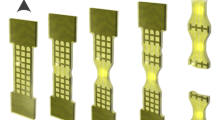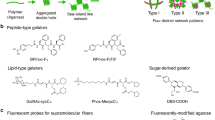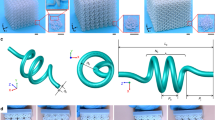Abstract
Living tissues show an extraordinary adaptiveness to strain, which is crucial for their proper biological functioning1,2. The physical origin of this mechanical behaviour has been widely investigated using reconstituted networks of collagen fibres, the principal load-bearing component of tissues3,4,5. However, collagen fibres in tissues are embedded in a soft hydrated polysaccharide matrix, which generates substantial internal stresses, and the effect of this on tissue mechanics is unknown6,7,8. Here, by combining mechanical measurements and computer simulations, we show that networks composed of collagen fibres and a hyaluronan matrix exhibit synergistic mechanics characterized by an enhanced stiffness and delayed strain stiffening. We demonstrate that the polysaccharide matrix has a dual effect on the composite response involving both internal stress and elastic reinforcement. Our findings elucidate how tissues can tune their strain-sensitivity over a wide range and provide a novel design principle for synthetic materials with programmable mechanical properties.
This is a preview of subscription content, access via your institution
Access options
Access Nature and 54 other Nature Portfolio journals
Get Nature+, our best-value online-access subscription
$29.99 / 30 days
cancel any time
Subscribe to this journal
Receive 12 print issues and online access
$209.00 per year
only $17.42 per issue
Buy this article
- Purchase on Springer Link
- Instant access to full article PDF
Prices may be subject to local taxes which are calculated during checkout




Similar content being viewed by others
Data availability
The data that support the plots within this paper and other findings of this study are available from the corresponding authors upon reasonable request.
References
Fung, Y. C. Elasticity of soft tissues in simple elongation. Am. J. Physiol. 213, 1532–1544 (1967).
Hall, M. S. et al. Fibrous nonlinear elasticity enables positive mechanical feedback between cells and ECMs. Proc. Natl Acad. Sci. USA 113, 14043–14048 (2016).
Motte, S. & Kaufman, L. J. Strain stiffening in collagen I networks. Biopolymers 99, 35–46 (2013).
Licup, A. J. et al. Stress controls the mechanics of collagen networks. Proc. Natl Acad. Sci. USA 112, 9573–9578 (2015).
Sharma, A. et al. Strain-controlled criticality governs the nonlinear mechanics of fibre networks. Nat. Phys. 12, 584–587 (2016).
Narmoneva, D. A., Wang, J. Y. & Setton, L. A. Nonuniform swelling-induced residual strains in articular cartilage. J. Biomech. 32, 401–408 (1999).
Michalek, A. J., Gardner-Morse, M. G. & Iatridis, J. C. Large residual strains are present in the intervertebral disc annulus fibrosus in the unloaded state. J. Biomech. 45, 1227–1231 (2012).
Voutouri, C. & Stylianopoulos, T. Accumulation of mechanical forces in tumors is related to hyaluronan content and tissue stiffness. PLoS ONE 13, 0193801 (2018).
Lanir, Y. Multi-scale structural modeling of soft tissues mechanics and mechanobiology. J. Elast. 129, 7–48 (2017).
van Helvert, S., Storm, C. & Friedl, P. Mechanoreciprocity in cell migration. Nat. Cell Biol. 20, 8–20 (2018).
Storm, C., Pastore, J. J., MacKintosh, F. C., Lubensky, T. C. & Jamney, P. A. Nonlinear elasticity in biological gels. Nature 435, 191–194 (2005).
Holmes, D. F., Lu, Y., Starborg, T. & Kadler, K. E. Collagen fibril assembly and function. Curr. Top. Dev. Biol. 130, 107–142 (2018).
Broedersz, C. P. & MacKintosh, F. C. Modeling semiflexible polymer networks. Rev. Mod. Phys. 86, 995 (2014).
Maxwell, J. C. On the calculation of the equilibrium and stiffness of frames. Philos. Mag. 27, 294–299 (1864).
Onck, P. R., Koeman, T., van Dillen, T. & van der Giessen, E. Alternative explanation of stiffening in cross-linked semiflexible networks. Phys. Rev. Lett. 95, 178102 (2005).
Mouw, J. K., Ou, G. & Weaver, V. M. Extracellular matrix assembly: a multiscale deconstruction. Nat. Rev. Mol. Cell Biol. 15, 771–785 (2014).
van Doorn, J. M., Lageschaar, L., Sprakel, J. & van der Gucht, J. Criticality and mechanical enhancement in composite fiber networks. Phys. Rev. E 95, 042503 (2017).
Shahsavari, A. S. & Picu, R. C. Exceptional stiffening in composite fibre networks. Phys. Rev. E 92, 012401 (2015).
Lai, V. K. et al. Swelling of collagen–hyaluronic acid co-gels: an in vitro residual stress model. Ann. Biomed. Eng. 44, 2984–2993 (2016).
Rankin, K. S. & Frankel, D. Hyaluronan in cancer—from the naked mole rat to nanoparticle therapy. Soft Matter 12, 3841–3848 (2016).
Berezney, J. P. & Saleh, O. A. Electrostatic effects on the conformation and elasticity of hyaluronic acid, a moderately flexible polyelectrolyte. Macromolecules 50, 1085–1089 (2017).
Jansen, K. A. et al. The role of network architecture in collagen mechanics. Biophys. J. 114, 2665–2678 (2018).
Vahabi, M. et al. Elasticity of fibrous networks under uniaxial prestress. Soft Matter 12, 5050–5060 (2016).
van Oosten, A. S. S. G. et al. Uncoupling shear and uniaxial elastic moduli of semiflexible biopolymer networks: compression-softening and stretch-stiffening. Sci. Rep. 6, 19270 (2016).
Shayegan, M., Altinda, T., Kiefl, E. & Forde, N. R. Intact telopeptides enhance interactions between collagens. Biophys. J. 111, 2404–2416 (2016).
Koenderink, G. H. et al. An active biopolymer network controlled by molecular motors. Proc. Natl Acad. Sci. USA 106, 15192–15197 (2009).
Jansen, K. A., Bacabac, R. G., Piechocka, I. K. & Koenderink, G. H. Cells actively stiffen fibrin networks by generating contractile stress. Biophys. J. 105, 2240–2251 (2013).
Mizuno, D., Tardin, C., Schmidt, C. F. & Mackintosh, F. C. Nonequilibrium mechanics of active cytoskeletal networks. Science 315, 370–373 (2007).
Cosgrove, D. J. Growth of the plant cell wall. Nat. Rev. Mol. Cell Biol. 6, 850–861 (2005).
Jaspers, M. et al. Nonlinear mechanics of hybrid polymer networks that mimic the complex mechanical environment of cells. Nat. Commun. 8, 15478 (2017).
Broedersz, C. P. et al. Measurement of nonlinear rheology of cross-linked biopolymer gels. Soft Matter 6, 4120–4127 (2010).
Jansen, K. A. et al. The role of network architecture in collagen mechanics. Biophys. J. 114, 2665–2678 (2018).
Schindelin, J. et al. Fiji: an open-source platform for biological-image analysis. Nat. Methods 9, 676–682 (2012).
Kaufman, L. J. et al. Glioma expansion in collagen I matrices: analyzing collagen concentration-dependent growth and motility patterns. Biophys. J. 89, 635–650 (2005).
Kim, A. J., Manoharan, V. N. & Crocker, J. C. Swelling-based method for preparing stable, functionalized polymer colloids. J. Am. Chem. Soc. 127, 1592–1593 (2005).
Allan, D., Caswell, T., Keim, N. & van der Wel, C. trackpy: Trackpy v0.3. 2 https://zenodo.org/record/60550#.XFcZKsSnxPY (Zenodo, 2016).
Sharma, A. et al. Strain-controlled criticality governs the nonlinear mechanics of fibre networks. Nat. Phys. 12, 584–587 (2016).
Broedersz, C., Mao, X., Lubensky, T. C. & Mackintosh, F. C. Criticality and isostaticity in fibre networks. Nat. Phys. 7, 983–988 (2011).
van Doorn, J. M., Lageschaar, L., Sprakel, J. & van der Gucht, J. Criticality and mechanical enhancement in composite fiber networks. Phys. Rev. E 95, 042503 (2017).
Licup, A. J. et al. Stress controls the mechanics of collagen networks. Proc.Natl Acad. Sci. USA 112, 9573–9578 (2015).
Lindström, S. B., Vader, D. A., Kulachenko, A. & Weitz, D. A. Biopolymer network geometries: characterization, regeneration and elastic properties. Phys. Rev. E 82, 051905 (2010).
Bitzek, E., Koskinen, P., Gähler, F., Moseler, M. & Gumbsch, P. Structural relaxation made simple. Phys. Rev. Lett. 97, 170201 (2006).
Acknowledgements
The authors thank F. C. MacKintosh (Rice University, Texas), E. Pelan (University of Birmingham), K. Jansen (UMC, Utrecht) and S. Stoyanov (Unilever B.V., the Netherlands) for many useful discussions, A. Sharma (Leibniz Institute for Polymer Research, Dresden) for the MatLab script for determining the bending rigidity of collagen fibres from rheology data, D. Nedrelow (University of Minnesota) for suggestions regarding the sample preparation, K. Miura (EMBL, Heidelberg, Germany) for the Temporal Colour Code ImageJ plugin and J. T. B. Overvelde (AMOLF, Amsterdam) for a critical reading of the manuscript. The work of F.B. and G.H.K. is part of the Industrial Partnership Programme Hybrid Soft Materials, which is carried out under an agreement between Unilever Research and Development B.V. and the Netherlands Organisation for Scientific Research (NWO). The work of J.T., S.D. and J.v.d.G. is part of the SOFTBREAK project funded by the European Research Council (ERC Consolidator Grant).
Author information
Authors and Affiliations
Contributions
F.B. and G.H.K designed the experiments. F.B. performed and analysed the experiments under the supervision of G.H.K. J.T. and S.D. designed, performed and analysed the simulations under the supervision of J.v.d.G. All authors interpreted and discussed the results and co-wrote the paper.
Corresponding authors
Ethics declarations
Competing interests
The authors declare no competing interests.
Additional information
Journal peer review information: Nature Physics thanks Wouter Ellenbroek, Spencer Lake and Tom Shearer for their contribution to the peer review of this work.
Publisher’s note: Springer Nature remains neutral with regard to jurisdictional claims in published maps and institutional affiliations.
Supplementary information
Supplementary Information
Supplementary Figures 1–20 and Supplementary References 1–7.
Rights and permissions
About this article
Cite this article
Burla, F., Tauber, J., Dussi, S. et al. Stress management in composite biopolymer networks. Nat. Phys. 15, 549–553 (2019). https://doi.org/10.1038/s41567-019-0443-6
Received:
Accepted:
Published:
Issue Date:
DOI: https://doi.org/10.1038/s41567-019-0443-6



